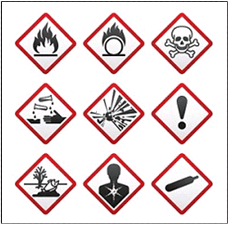The production and use of chemicals has become a fundamental component of many industries. According to the Occupational Safety & Health Administration (OSHA): the global chemical business is more than a $1.7 trillion per year enterprise. In the U.S., chemicals are a $450 billion business and exports are greater than $80 billion per year.
Though these chemicals provide a multitude of benefits, they also carry some risks. Consequently, many countries have developed laws and regulations to ensure clear reporting for safe chemical trade. Labeling and MSDS (Material Safety Data Sheets) or SDS (Safety Data Sheets in Europe,) are an integral part of ensuring occupational safety and health and a significant part of international trade regulations. MSDS are required for any chemical product or mix which is classified as a physical, health, or environmental hazard. The recoded information on the labels and MSDS is essential for every part of the chemical lifecycle process, from research and production to transport, handling, use, and disposal.
When these chemicals are shipped internationally, the labels and MSDS need to be translated into the recipient countries languages. For example in Canada, there needs to be both English and French translations of both the labels and the MSDS.
GHS
Until recently, there were many different regulations on hazard classification in use in different countries. While existing laws and regulations in labeling are similar, they differ enough to require multiple versions of labels and MSDS for the same product even within the United States. The same chemical may be classified as carcinogenic in one country, but not in another.. Given the scope of global trade in chemicals, and the risk to neighboring countries when proper controls are not implemented, it was determined that a worldwide approach was necessary.
To homogenize the labeling and reporting process, the United Nations devised and passed The Globally Harmonized System of Classification and Labeling of Chemicals (GHS). The GHS is an internationally agreed-upon system that ensures that all chemicals are processed with the same hazard communication system, including: classification criteria and hazard statements, including symbols and signal words, regardless of the country handling the chemicals. This system has been adopted in many countries including in Europe, Canada and the US. However, the GHS is not a global law or regulation—it is a system. It is a set of guidelines and best practices– no country is obligated to adopt the whole system. This is explained in more detail on the United Nations Economic Commission for Europe website.
Implementation
The GHS was implemented in the EU in 2009 and the deadline for compliance with the system for pure substances was in 2010, with the deadline for GHS compliance for mixtures being June 1st 2015. In the US, the deadline for implementation for both substances and mixtures will take place on May 31st 2015. The Canadian deadline is set for June 1st 2015, however this may be subject to change.
With these approaching deadlines, many businesses will need to adapt their MSDS’ to be in line with the GHS, as well as translate them into the official language(s) of each country or market where their chemicals are being produced, sold, or shipped.
Contact Morningside to see how our specialized team of technical translators can help you with this process.


